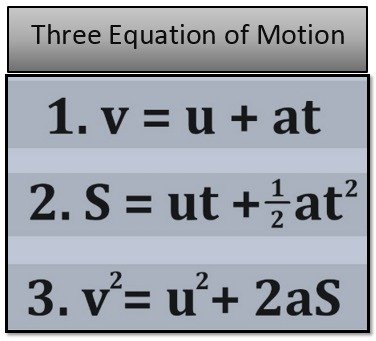Three equations of motion
Three equations of motion

Three equations of motion
Who developed the three equations of motion?
Sir Isaac Newton was additionally honoured with the idea of the three equations of motion.
Also known as Newton's equations of motion, the three equations of motion describe the relationship between an object's position, velocity, acceleration, and time. These equations are fundamental principles of classical mechanics and are often used to solve problems related to motion. These are the three equations of motion:
First equation of motion (or equation of motion at constant speed):
This equation relates initial velocity, terminal velocity, acceleration, and the time it takes for an object to move from one location to another, assuming velocity is constant.
Equation: v = u + at
Where:
v - final velocity of the object
u - initial speed of the object
a is the constant acceleration experienced by the object
t is the time it takes to move
In this equation, it is assumed that the acceleration ' remains constant throughout the motion. It's important to note that this equation is valid only for motion in a straight line with constant acceleration.
If the acceleration is zero (no net force acting on the object), the equation simplifies to:
This equation represents the equation of motion for uniform or constant velocity, where the displacement is directly proportional to the time elapsed.
Remark. If the acceleration (a) is zero, the object is moving at a constant speed.
The second equation of motion (or the equation of motion at constant acceleration):
This equation relates initial velocity, terminal velocity, acceleration, displacement, and the time it takes for an object to move from one location to another with constant acceleration.
Equation:
s = ut + (1/2)at^2
Where:
s - offset or distance traveled by the object
u - initial velocity of the object
a is the constant acceleration experienced by the object
t is the time it takes to move
Remark. This equation assumes that the object comes from rest at t = 0, so the initial velocity (u) is zero.
Third equation of motion (or equation of motion involving displacement, velocity, and acceleration):
This equation relates the displacement, initial velocity, terminal velocity, and acceleration of an object independently of time.
Equation:
v^2 = u^2 + 2as
Where:
v - final velocity of the object
u - initial speed of the object
a is the constant acceleration experienced by the object
s - offset or distance traveled by the object
Remark. This equation can be derived from the first two equations of motion by removing time (t).
Application of three equations of motion:
Three equations of motion, also called kinematic equations, describe the motion of objects with constant acceleration. They can be used to solve many motion-related problems and are widely used in physics and technology. Here are some common applications of the three equations of motion:
Projectile Motion:
Equations of motion are often used to analyze the motion of projectiles, such as a ball thrown through the air or a bullet fired from a gun. These equations can be used to calculate the projectile's maximum height, time of flight, and range by taking into consideration the muzzle velocity, throw angle, and gravitational acceleration.
Free Fall:
When an object falls freely under gravity, three equations of motion can be used to calculate its displacement, velocity, and time of fall. This is especially useful in scenarios such as calculating the time it takes for an object to fall from a certain height or determining the speed of an object just before it hits the ground.
Uniformly accelerated motion:
If an object experiences constant acceleration, equations of motion can be used to analyze its motion. This refers to situations where objects move in a straight line under a constant force, such as a car accelerating from a standstill or an object falling down without air resistance. The equations can help determine various parameters, such as terminal velocity, elapsed time, and covered displacement.
Motion analysis:
The equations of motion are a valuable tool for motion analysis, where the motion of objects is studied without regard to the forces that cause the motion. They enable engineers and scientists to analyze and predict the behavior of moving objects to aid in the design of structures, machines and vehicles. For example, they can be used to calculate the time it takes for a car to come to a complete stop or to determine how far an object travels in a given time.
Circular Motion:
The equations of motion can also be applied to objects moving at a constant speed in a circular path, such as a car making a turn or a satellite orbiting a planet. Given the centripetal acceleration and the radius of the circular path, the equations can be used to determine the speed, displacement, and time period of the motion.
These are just a few examples of how the three equations of motion can be applied in different scenarios. They provide a mathematical basis for understanding and predicting the movement of objects under different conditions.
What's Your Reaction?





















